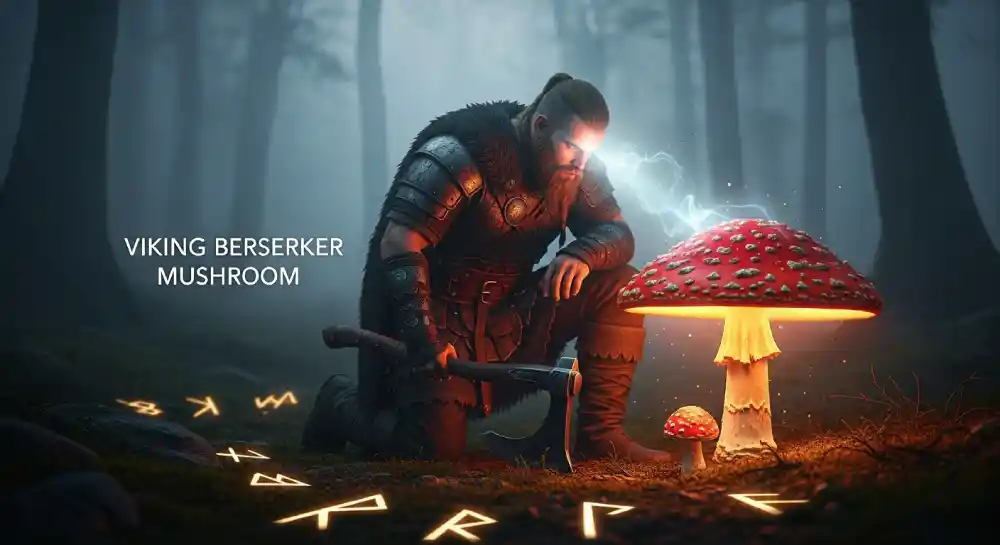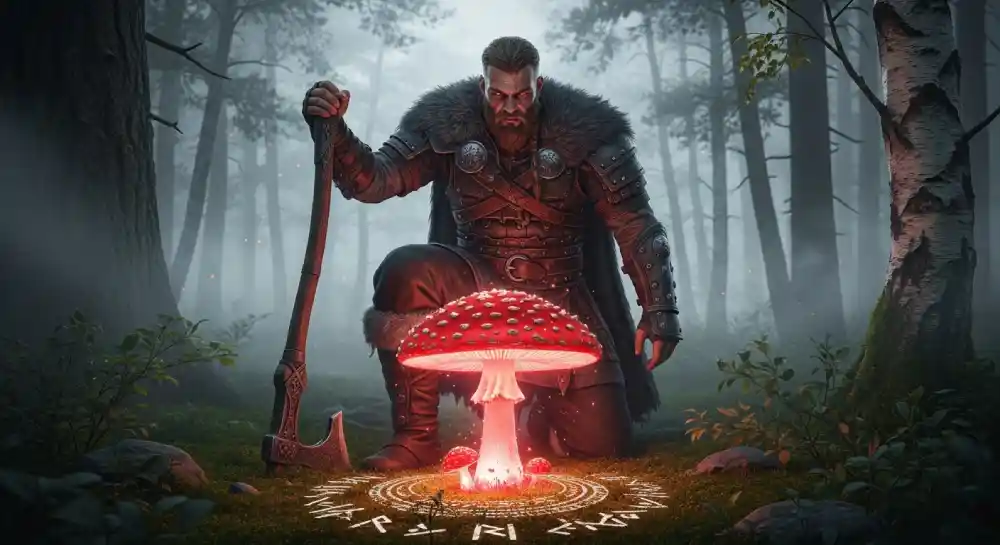Berserker Mushroom: Viking Rage Myth, History & Real Effects (2025)
For centuries, the image of a Viking warrior roaring into battle-eyes wide, body shaking, seemingly unstoppable, has fascinated historians and fans alike. These fearsome fighters were called Berserkers, and legend says their unmatched fury came from a mysterious “Berserker Mushroom“.

But was it real? Did Viking warriors truly eat mushrooms to summon supernatural rage or is it just another myth born from Norse storytelling? Let’s separate history from hallucination.
What Is a Berserker Mushroom?
The Berserker Mushroom refers to a legendary fungus believed to give Viking warriors their uncontrollable strength and fearlessness in battle. Historians and ethnobotanists have long debated which species it could have been.
The most popular theory points to Amanita muscaria, commonly known as the Fly Agaric Mushroom – the bright red cap with white dots you’ve seen in fairy tales. This mushroom contains psychoactive compounds that can alter perception, reduce pain sensitivity, and create a sense of invincibility.
Other theories suggest Panther Cap (Amanita pantherina) or other Nordic fungi with similar properties could have been used.
Amanita Muscaria Mushroom Chocolate Bar (1800 MG)
The Viking “Battle Rage” – Fact or Fungi?
The word Berserker itself comes from Old Norse—“ber” (bear) and “serkr” (shirt)—meaning “bear-shirted” or “bare-chested.” It describes warriors who fought in a trance-like state, often without armor, howling and striking with inhuman ferocity.
Early Norse sagas describe this berserker rage as uncontrollable and powerful, almost divine. Many modern researchers propose that hallucinogenic mushrooms could explain this behavior. The psychoactive effects of Amanita muscaria can include:
- Distorted perception of danger
- Boosted adrenaline
- Temporary numbness to pain
- Euphoria and loss of inhibition
When combined with the religious rituals and battle chants of Viking culture, it’s easy to see how such substances could feed the myth of invincible warriors.
Is the Berserker Mushroom Real?
While captivating, the evidence is still largely circumstantial. No archaeological discovery has definitively linked Viking berserkers to mushroom use. Yet, several ethnographic parallels exist Siberian shamans used Amanita muscaria for spiritual journeys and strength ceremonies centuries before the Viking Age.
Scientifically, Amanita muscaria contains muscimol and ibotenic acid, two compounds known to cause hallucinations, muscle twitching, and bursts of energy followed by deep sleep. Such effects align perfectly with the berserker legends—frenzied fighting followed by total exhaustion.
However, some historians argue that psychological training, rituals, and sheer adrenaline could equally explain the berserker trance. The truth likely lies somewhere in between – a blend of ritual, belief, and maybe a mushroom or two.

Berserker Mushroom in Pop Culture
The legend of the Berserker Mushroom still inspires modern storytelling:
- Vinland Saga (Anime): Bjorn consumes a mysterious mushroom before battle, transforming into a raging beast a direct nod to the Norse myth.
- Assassin’s Creed: Valhalla (Game): Players experience hallucinogenic mushroom sequences and visit a “Berserker House,” connecting gameplay with Viking psychedelia.
- Orna RPG & Fantasy Titles: Often feature “Berserker Mushroom” items or buffs granting temporary rage or power.
These modern appearances prove that the fascination with Viking strength and its mystical source still thrives today.
Berserker Mushroom Effects (If It Were Real)
If Vikings truly consumed Amanita muscaria, here’s what they might have experienced:
| Effect | Description |
|---|---|
| Euphoria / Energy Rush | Sudden surge of power and fearlessness |
| Pain Suppression | Reduced sensation of injury or fatigue |
| Altered Perception | Time and motion feel distorted |
| Aggression Increase | Heightened emotional state, possibly violent |
| Toxic After-Effects | Nausea, confusion, heavy fatigue after the peak |
⚠️ Disclaimer: Amanita muscaria is not safe for casual use. It can be toxic if improperly prepared and should never be used for experimentation. Modern scientific research focuses on controlled micro-dosing studies only not self-consumption.
Final Thoughts – Myth, Medicine, or Mystery?
The Berserker Mushroom sits at the crossroads of myth, neurochemistry, and Norse legend. Whether Vikings truly ate hallucinogenic mushrooms or simply reached battle fury through ritual and belief, the idea endures because it speaks to something primal – our fascination with courage, transformation, and the thin line between human and beast.
In 2025, as researchers continue exploring psychedelic therapy, the Berserker Mushroom legend feels strangely modern—a reminder that ancient humans may have understood altered states of mind better than we think.
Don't Just Take Our Word For IT

“I’ve tried many vape products claiming to use real terpenes, but this one truly delivers. The flavors are vibrant and true to the source, and the hits are incredibly smooth. It’s evident that a lot of care and attention to detail went into creating this product”
Sasha Belker
Princeton, New Jersey

“Loving the Amanita Chocolate Bar! In San Diego I’m always up for a good time, and this is my new go-to. Just one piece and I feel amazing—way better than a drink. Perfect for unwinding and sparking creativity without the hangover.”
Julia Chastely
Malibu, California

Christopher Jenner
Mar Vista, California

“The best cartridge for taking on the boat and to the beach with my girls. Only problem is, they always ask to smoke MY pen because the flavor is amazing! Stocking up!”
Amy Rodgers
Miami, Florida

Karla Doughty
Charleston, South Carolina





